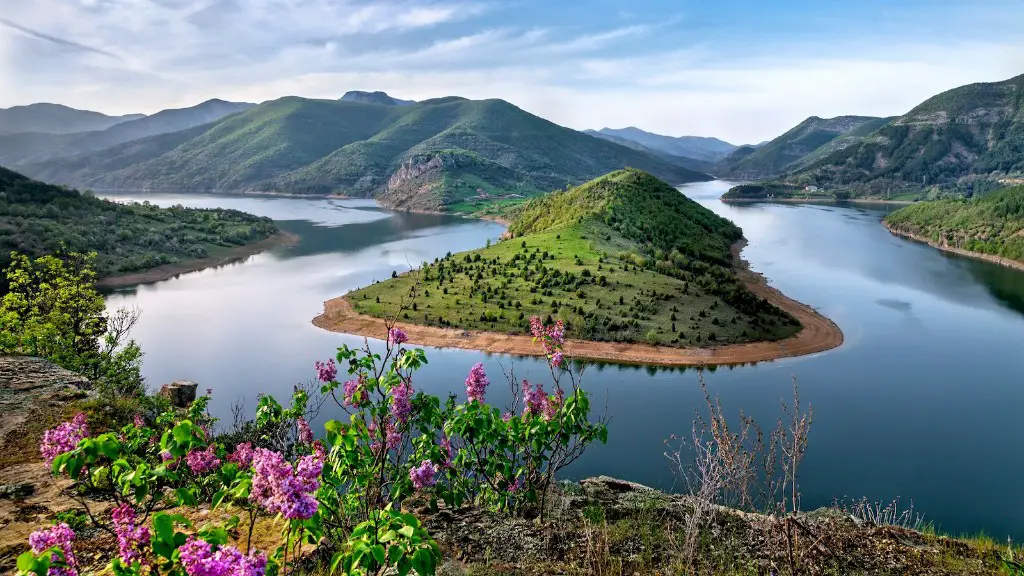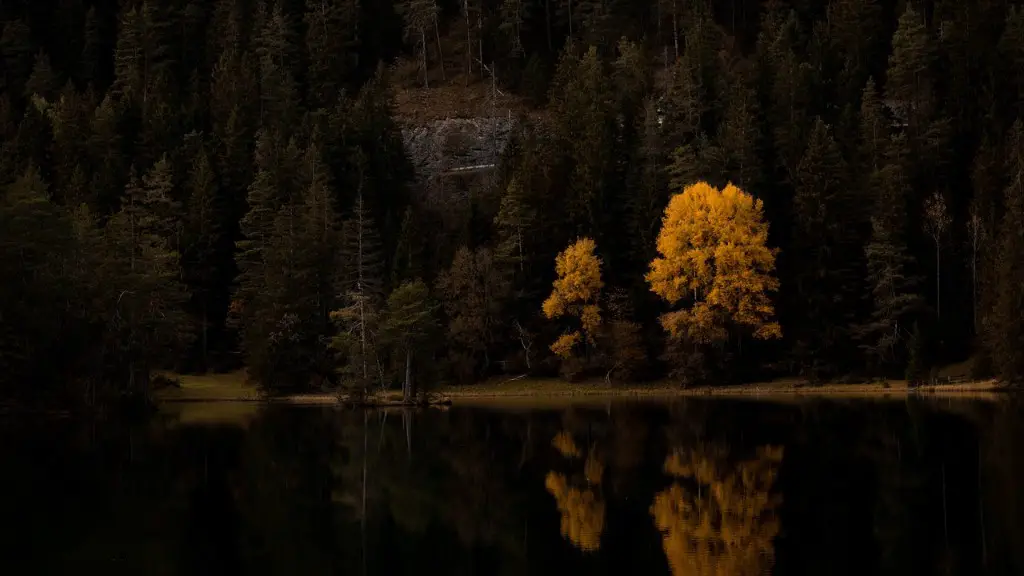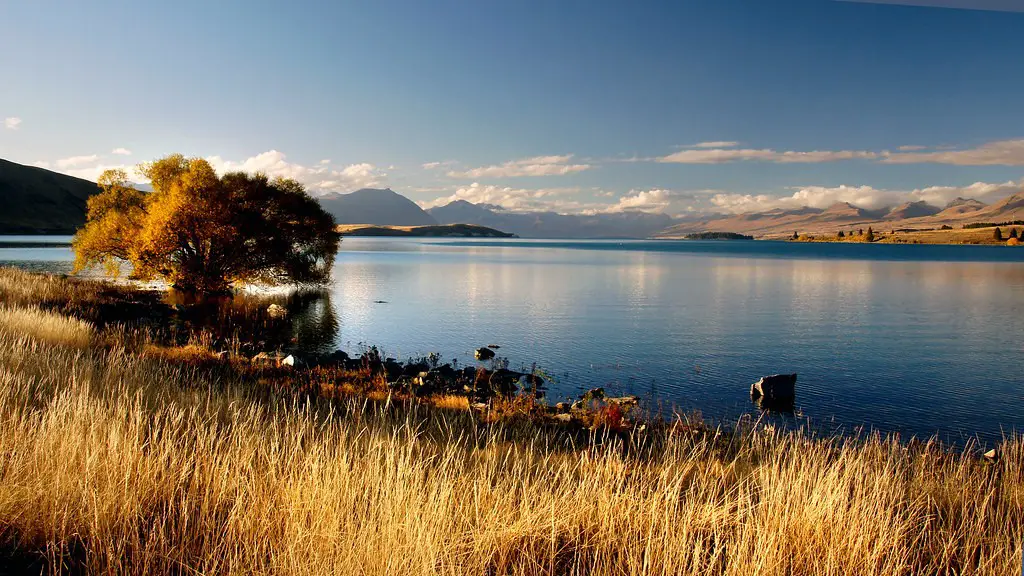Lake Titicaca is one of the world’s most famous and largest freshwater lakes, situated high in the Andes Mountains between Peru and Bolivia. It is a majestic place and considered by many to be a sacred site. In terms of size, Lake Titicaca is the largest lake in South America and is estimated to have an area of roughly 8,372km2. It is also thought to be the highest navigable lake in the world with some parts sitting at 3812m above sea level.
The lake has a long history of human inhabitants, with some scholars believing that it has been home to humans since 4000BC. There are many stories and myths surrounding the lake, with many people believing the lake to have mystical powers or origins. This belief gives the lake an extra layer of importance for both locals and visitors.
Lake Titicaca is an incredibly biologically diverse lake and it provides a vital habitat for many endangered species of fish, birds and plants. It is thought that the lake also holds a large number of medicinal plants and some local stories suggest that these will be revealed over time. Alongside its biodiversity, the lake is a very important resource for both Peru and Bolivia with many people relying on the lake for drinking water and fishing for their livelihood.
The water quality of the lake has been an increasing problem in recent years as the lake has become increasingly polluted. This is due to a number of factors, most notably the heavy use of nutrients and pollutants being introduced to the lake from upstream. In addition, the increasing population size of the people living around the lake has been a contributing factor. This has presented a major challenge to the governments of Peru and Bolivia as the quality of the water is a major health concern, as well as the impact on both the environment and the species that inhabit the lake.
The conservation of the lake is a priority for both countries and they have both taken steps to clean up the lake, as well as introduce tighter regulations to protect it from further harm. One of the key initiatives has been the introduction of a territorial management plan which has resulted in a communal fishing and boating program on the lake in order to safeguard it for the future.
The future of Lake Titicaca is uncertain. It is a lake of huge ecological importance and its conservation is paramount. Despite the pollution, the lake remains a stunningly beautiful site and a key tourist destination and it will continue to play an important part in the lives of the people who inhabit the surrounding area.
Challenges posed by Climate Change
Climate change is an increasingly urgent threat facing Lake Titicaca and its inhabitants. One of the biggest impacts of climate change on the lake is the increasing water temperature and decreased water quality. As the water warms, there is an increased risk of algal blooms, which can cause harm to the local ecosystem as well as increase the risk of health and wellbeing issues for those living and working in the area.
The impact of melting glaciers from around the region is also a major concern. This can result in a decrease in water levels in the lake and an increased risk of flooding in the surrounding areas due to increased runoff from the glaciers.
In addition to the physical effects of climate change, the social and economic impacts are also significant. Extreme weather events can have a huge impact on the livelihood of those living around the lake as they are highly reliant on the lake for food and income. In addition, extreme weather affects tourism, as decreased water levels can make the lake un-navigable and increased flooding in the local area can make it difficult to traverse through the region.
The challenge of climate change is one that will require concerted efforts from both countries and international organisations alike, to safeguard the lake and the people who inhabit it.
Efforts to Protect Lake Titicaca
The governments of Peru and Bolivia have committed to a variety of initiatives to protect Lake Titicaca. These include introducing tighter regulations to protect from pollution and increased surveillance of the lake to ensure its environmental safety.
In addition, a number of charities and non-profit organisations are working towards the protection of the lake and its inhabitants. These organisations are working to raise awareness, as well as lobbying governments and businesses to take action to protect the lake. They are also helping to fund initiatives on the ground, such as the implementation of sustainable farming practices and the introduction of cleaner energy sources.
International organisations such as the United Nations are also taking part in the restoration process, with the UN providing funds and resources to help local communities. They are also helping to implement international policies to combat emissions and promote agriculture that is in line with sustainable development goals.
The future of Lake Titicaca is uncertain, however, with concerted and collaborative efforts from all parties it is hoped that the lake can be safeguarded for years to come.
Economic Impact of Lake Titicaca
The economic impact of Lake Titicaca is significant, with the lake providing a key source of income for the local communities that inhabit the surrounding area. Fishing is the primary source of income for the local communities, with some estimates suggesting that fishing provides up to 75% of the total revenue for the local population.
In addition, the lake is also a key tourist destination, with many people visiting to take part in recreational activities, such as kayaking, sailing or bird watching. This has resulted in a growing number of hotels, restaurants and tour companies around the lake. These local businesses have further boosted the economy by providing jobs and increased opportunities for economic growth.
The local communities are highly dependent on the lake and its resources and it is thought that any decrease in water levels or increase in pollution could have a severe impact on the economy and the livelihood of people in the area.
The government of Peru is currently working on a variety of initiatives to promote sustainable development in the region, such as introducing tighter regulations for tourism and encouraging responsible use of the lake’s resources. This is an important step in mitigating the potential impacts of climate change and ensuring that the lake remains a vital source of income for those who live and work by it.
Cultural Significance of Lake Titicaca
The lake has long held a spiritual and cultural significance for many of the local people that inhabit the surrounding area. The lake is seen as a sacred place and it is believed by many to possess magical powers. As such, many local ceremonies and rituals are conducted near the lake, some of which have been passed down through generations.
The lake is also a source of inspiration for local artists and writers, who take inspiration from its unique beauty and the stories and myths that surround it. Local writers have penned many works on the lake, including popular stories and poetry. This, in turn, has helped to bring the lake to the wider attention of people around the world.
The importance of the lake to the region has been further highlighted by the recent establishment of the Lake Titicaca Biosphere Reserve, which was created to protect the lake from any potential damage and preserve the cultural values of the local population.
In conclusion, the Lake Titicaca has a rich history and cultural significance for the people who inhabit the area. From its ecological importance to its spiritual significance, the lake has played an important role in the lives of the people who live around it and efforts are being made to ensure that it is protected for future generations.
International Influence
The lake has long been of international interest and most recently, the lake has gained international fame and recognition as the location of the 2019 Latin American Summit, which was hosted by Peru and Bolivia. This summit highlighted the importance of the lake and showcased the unity of Latin American countries, in the face of increasing global challenges.
The lake has also been the focus of a number of research initiatives, with organisations from around the world such as NASA, studying the lake in an effort to gain more insight into the impact of climate change. This research has been hugely beneficial to both countries, with a better understanding of the lake providing important insights into the potential future of the area.
In addition, the lake has also been the focus of a number of international exhibitions, with a variety of organisations visiting to share their knowledge and to gain a better understanding of the lake and its peoples. This has provided an important platform for debate and discussion on a variety of topics including the environment, climate change and tourism.
The international interest in Lake Titicaca is a testament to its significance, both in the region and around the world. As such, it is a key source of pride for both Peru and Bolivia and efforts are being made to ensure that both countries continue to collaborate and work together to protect the lake and its inhabitants.
Sustainability of Lake Titicaca
The sustainability of Lake Titicaca is of increasing importance and a number of initiatives are being undertaken to ensure its future. The governments of Peru and Bolivia have developed a number of plans to protect the lake from further degradation, with a focus on improving the quality of the lake and reducing pollution.
In addition, the local population is working on initiatives such as the introduction of sustainable farming practices and projects to restore and protect the lake’s ecosystem. These initiatives are key to the sustainability of the lake, as they are helping to reduce the pressure on the lake’s resources and providing alternative sources of income for the local population.
The international community is also playing an important role in the sustainability of the lake. Funding has been provided by organisations such as UNESCO and the United Nations to help support local initiatives and promote sustainable development in the region. In addition, funds have been provided to support research into the lake and its effects.
Ultimately, the future of the lake rests in the hands of both the local and international community. With concerted efforts and collaboration, the lake will remain a vital resource for the region and a source of pride for both Peru and Bolivia.





